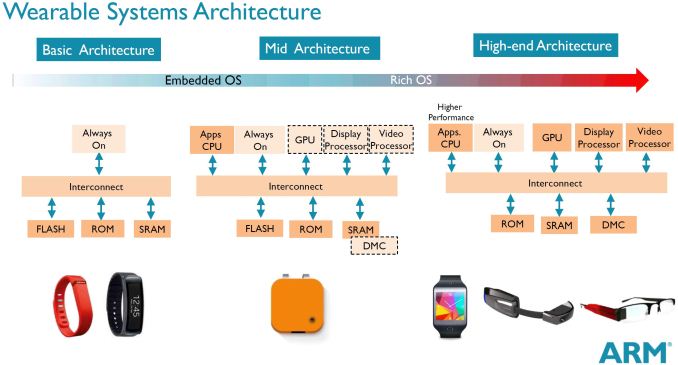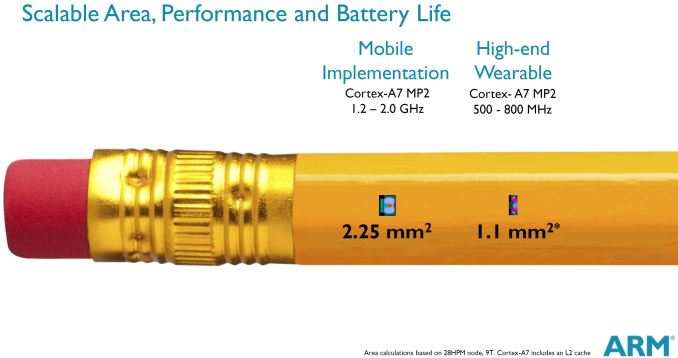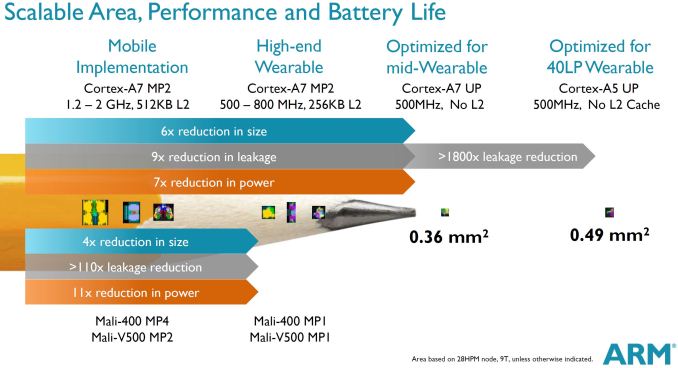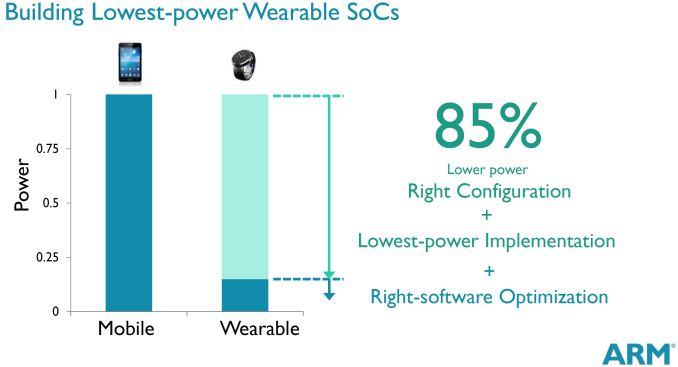Cortex-M7 Launches: Embedded, IoT and Wearables
by Stephen Barrett on September 23, 2014 7:01 PM ESTHybrid Systems
While the Cortex-M series aims to be the MCU for many application markets including IoT and wearables, ARM does not expect M series processors to always be used alone and expects many devices to combine A series application processors with the M seires. When I mentioned the word coprocessor referring to the M series, Nandan quickly pointed out that in this market, the A series might actually be considered the coprocessor. Considering the MCU is the always on device and the A series CPU wakes only sparingly, I can see his point of view. The following diagram from ARM lays out this perspective well.
MediaTek used a much simpler table to describe the sub markets of IoT and wearables that, as I noted at the time, insinuated there was no overlap between MCUs and APs. I tend to agree more with Intel’s Edison platform and ARM’s slide here that there are large market segments that will indeed be combining these differentiated processors.
When designing hybrid systems like this for IoT and wearables, it is very important to synthesize the AP with power optimization goals. The process of synthesizing HDL to an ASIC is essentially an optimization problem, much like all engineering. Targeting one aspect of performance, such as power consumption, means you’re willing to sacrifice something else. The prevailing trend so far has been to reuse smartphone processors in wearables. Companies practicing this approach are not optimizing their wearables' power use but are instead optimizing time to market and internal expenses.
To emphasize what this means, when the Cortex A15 launched ARM stated it was optimized for 1.2 GHz operation. When the first smartphone featuring an A15 hit the market it actually ran at much higher voltages to achieve higher frequencies and thus relatively high power consumption. Reusing this chip inside an IoT or wearable device is not only choosing a performance focused CPU instead of a power optimized one like the A7, but it has also been synthesized to further push the CPU away from power efficiency. This is why many wearables today featuring rich operating systems have struggled with battery life. Apple has traditionally been conservative with smart phone SoC power consumption and it will be interesting to see how their new wearable is designed.
For wearable devices, ARM recommends reducing A series frequency and area by over half, which has a direct effect on power consumption. ARM states that wise choices of CPU cores and caches, synthesis goals, and software optimizations to offload certain tasks to an MCU, can reduce power consumption by as much as 85%. This will be something we will keep an eye on when we review future wearables.














43 Comments
View All Comments
Guspaz - Tuesday, September 23, 2014 - link
"General purpose operating systems such as Linux (Android), Windows, OSX, and iOS require an MMU to function. That means M series processors, like all microcontrollers (MCUs), will never be tasked with running general purpose operating systems."This is incorrect: Linux runs on the Cortex M and other platforms that lack an MMU via uClinux. There are some differences, yes, but for the most part it's transparent to the developer, and most software runs unmodified.
extide - Tuesday, September 23, 2014 - link
This is true, but there are some pretty big limitations when using uClinux. I wouldn't suggest it unless you really really need it, heh.HardwareDufus - Tuesday, September 23, 2014 - link
Like the Cortex-M3 & M4, it is a 32-bit ARMv7-M core processor. I is said to use a six-stage superscalar pipeline.The ARM press release says that it will have highly flexible system and memory interfaces. Looking forward to seeing more details on that... (though of course it will lack a MMU).
It launches manufactured on a 40nm process and runs up to 400Mhz.
However it will move to a 28nm process in the near future, where performance is expected to double (so one can assume a near doubling of clock speed as well).
Atmel is already said to have a license. Will be interesting to see if the Arduino folks pick this processor up for a new Arduino board. Arduino has picked up the Cortex-0+ for the new Arduino ZERO and uses the Cortex-M3 for the Arduino DUE. But they've yet to use the Cortex-M4. Their latest board, the Arduino TRE uses a Texas Instruments Sitari chip which is a Cortex A series processor. So who knows what direction they are moving in.
Texas Instruments licenses the Cortex-M processors, but I haven't heard of a license for this new processor. I just picked up a nice development board that uses the Cortex-M4 from TI.
HardwareDufus - Tuesday, September 23, 2014 - link
Yes, I over used the phrase 'picked up' and cannot edit it. Feel free to substitute chose, selected, employed, used, etc...xenol - Wednesday, September 24, 2014 - link
Speaking from someone who's used MCUs and the M3/M4 series micro-controllers in development (professionally and hobby), I don't really see a point in using a general purpose OS on a small footprint. Something like this should be doing one thing and doing it very well.There are plenty of RTOSes out there that take up a very tiny footprint that will do memory management and "thread management" for you if you need it. Heck all of my projects have gotten away with doing amazing things without needing a heap (i.e., calling malloc).
The biggest thing I don't like about uCLinux is it requires external RAM. A lot of development boards don't have them.
akdj - Sunday, September 28, 2014 - link
Im curious as to which RTOS, micro controller or any other 'hobby or professional' use case that rivals this M7? It's footprint, efficiency, capabilities and phenomenal 'future' opportunities this motion sensor will provide. You're using vacuum tubes. As are all wearables to date. Those utiliIng this new ARM architecture will be moving directly to SolidState. Overnight. It's THAT HUGE!Best to 're-think' your tools and options, as using a micro-controller in your new project slated for mid 2015 release will be chewed up and spat to the floor by anyone using a 'currently available' M7. Difference between a typewriter and computer with Word Prodessor, with today's capabilities!
J
isa - Tuesday, September 23, 2014 - link
I can't apologize enough for my profound ignorance and stupidity, but what exactly were the 2 similar IoT anouncements on Anandtech in the last 2 days as referenced in the article? I can only find the Mediatek announcement. In the future, links to references would help stupid people like me.extide - Tuesday, September 23, 2014 - link
Mediatek, and this oneloftie - Tuesday, September 23, 2014 - link
If the embargo on the slides are correct, you published an hour early.Stephen Barrett - Tuesday, September 23, 2014 - link
Yeah the CMS failed me on daylight savings. Hopefully we will be forgiven ;-)